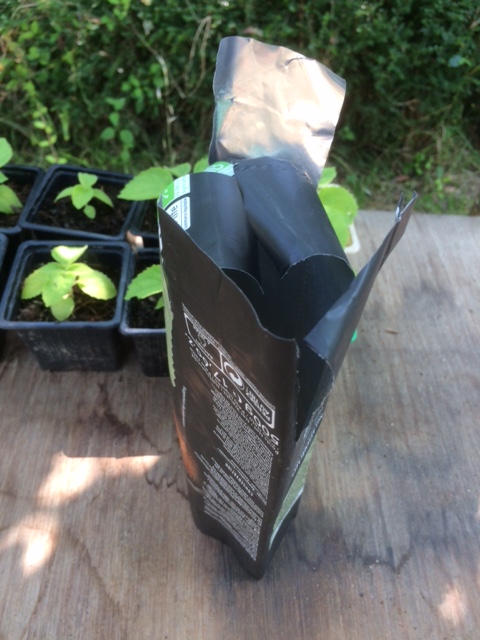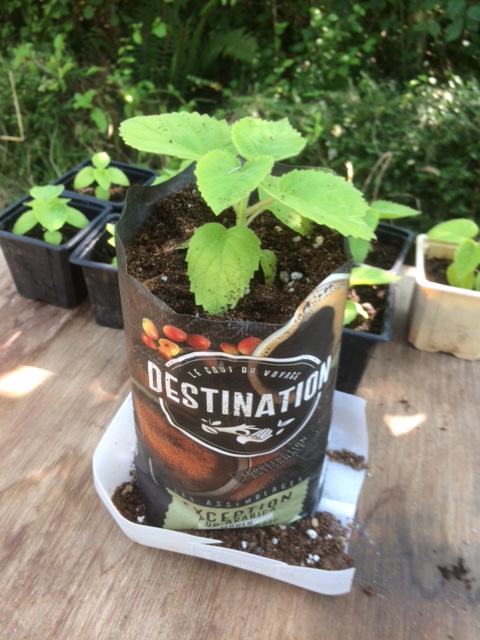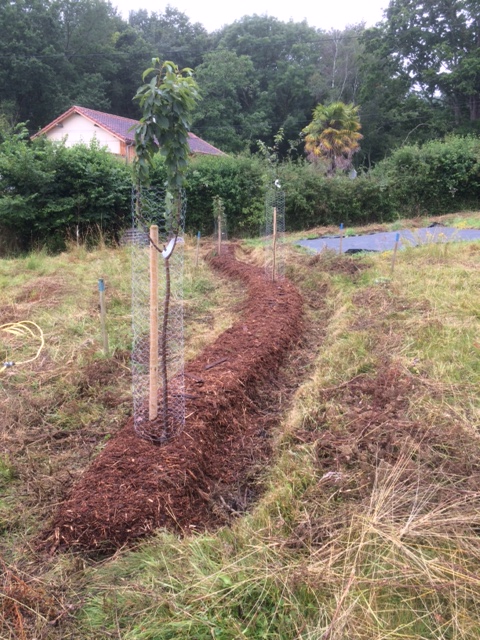(For my email subscribers: Remember to read this on the website – better design, more information, updates included, altogether a better experience!)
Early this month I decided I needed to cut back the Common Knapweed (Centaurea nigra) severely if it wasn’t to take over the whole garden! Last year it was just along both sides of the driveway, but this year it had set itself in swathes over a lot of the Upper Garden, restricting other plant growth. So the majority of it has been strimmed at what I judged to be the best time – after most of the other wild flowers were over for the season, and before the knapweed itself had a chance to set seed. It will of course come back, but it should be controllable now and should be greatly reduced.
There is also the question of ecosystems and ecological change. As mentioned in earlier Blogs, I have already noticed changes to the ecology of the Forest Garden in the short time it has been in existence, and controlling (but not eliminating) the knapweed will obviously have an effect too. But as more plants are added as the years go on, there will be change anyway, planned disturbance, so I consider this approach justifiable.
There was a choice to be made between allowing it to proliferate and exhaust itself/be suppressed as other plants grew and shaded it out, or to control it to keep it in proportion with the development of other plant life. I chose the latter. The Project is, at its most basic, about mimicking the natural development of a forest, but it is also about establishing a forest garden! There are therefore compromises to be made along the way.
On this subject there was an interesting online conference this month on Analog Forestry, which I had studied in Sri Lanka several years ago. The name comes from the meaning of the word ‘analogue’ (similar to, or ‘representative in different circumstances’ (OED)), and was coined by Dr. Ranil Senanayake several decades ago, and in whose analog forest I was working. When applied to forestry, it means adding a wide variety of species and levels, both native and exotic, mimicking the natural development of a forest, accelerating the succession process and the improvement of biodiversity and soil health, while at the same time providing the produce of the trees, shrubs, herbaceous plants and so on, not just their fruit but a whole range of other benefits as well – timber, edible leaves, fibre, fodder, etc. This is easily applied to a forest garden, and is what is happening here, albeit much more slowly!
The system is particularly suited to the tropics where it is widely practised, because of growth rates in hot and humid climates. Spectacular results can be obtained in a relatively short time – the forest in Sri Lanka had been planted only about 35 years ago and was already hard to distinguish from a natural one.
There has been more deer activity again this month, and even some trees in the Lower Garden, where they had not ventured before, needed protection. I have also now seen them for the first time, and in the middle of the day too! They were strolling quite at ease in the Upper Garden until I came along. Cutting back the knapweed around some of the trees was also an invitation for a nibble at some trees they had not bothered with before. To keep this in perspective, however, total losses to planted trees are just two, although others have been damaged and will take longer to establish themselves.
On tree establishment, many of the trees planted in early 2020 are now becoming autonomous, getting their roots established and not needing watering any more. This year’s trees are being watered on a regular basis during the summer months, but the weather in July (see below) has been kinder this year, and we are not in a drought situation yet.
I have spent some time mulching the new trees this month with the bark chippings obtained in June (see Blog, July 1st, 2021). Most of it has gone on the two swale banks (photo below), to help keep the banks weed-free until more plants are put in, but other new trees are getting their share as well. The black walnut in the left-hand photo is one of the trees that has really taken off, and most of the growth you can see has happened this year!
The paulownia seedlings are progressing nicely, and have now all been repotted (photos below) to grow on before planting out at the end of the year (see recent Blogs for the background to this). As you can see, there was already a healthy root system, and I adapted some coffee bags for the new pots, cutting some slits to be able to form a base, filling with a new compost/sand/perlite mix, and setting them out on a pallet in the courtyard. This is under a dogwood tree, which shades the young plants in the middle of the day when the sun is at its hottest. For planting out, the coffee bags can be simply slipped off, as the base has not been fixed, and used again.





I have started using leaves from the garden for salads – mostly nasturtium and dandelion so far – but this will increase greatly as the garden develops perennial vegetables and edible tree leaves. The rhubarb patch (Blog, July 1st, 2021) has already established itself and I have had the first crop. Conventional gardening advice says you should not harvest rhubarb in its first year, but these first stems and leaves were getting very big, and I wanted to get the light to the young ones underneath. Try cooking with freshly-grated ginger and just a little sugar to reduce the tang – delicious! The premature dropping of walnuts mentioned last month did not amount to much, and there is still what looks to be a good crop coming, and there have even been a few raspberries from the young plants on the upper swale. Next will be the mirabelles, a good crop of which is almost ready as I write. Besides simple stewing and compotes, and a couple of pots of jam, I am going to try some of these in the new dehydrator (Blog, May 1st, 2021), to see what Mirabelle prunes are like, and also make some Mirabelle leather!
The lentil patch ripened earlier than I was expecting, so I think it will need to be covered again temporarily until trees and shrubs are planted at the end of the year, to avoid regrowth of weeds. The haulms will be left on the ground to act as green manure. The beans here are looking good, and I am leaving two squash plants that have grown up from the biomass put down last year, as they are producing fruit.
Some comfrey ointment I made some time ago was put to the test this month on a swollen kneecap. A comfrey compress bandaged in place overnight for three nights, plus a little use of an icepack during the day, soon did the trick!
Hydrology and water management is one of the key aspects of the forest garden, and the swales in the Upper Garden (see photos above) play an important role. They are created along contour lines and thus trap equally any water running down the garden slope. This is the reason for planting on the banks below the ditches.
But there is more to be done! The lie of the land here and the position of the house mean that I can collect all the rainwater from both slopes of the roof, plus all the grey water from the house, and channel it across the courtyard into the Lower Garden. Here too swales will be created, and a 1000L tank buried to collect the rainwater, with an overflow to the swales. The underground water tank will have a solar-powered pump so that the water can be used throughout the garden. The grey water will go directly to the swales to permeate gently into the soil. As in the Upper Garden, banks will be created with the soil from the ditches and then gradually planted up.
In case you are wondering how the swales were created, I decided not to use expensive laser equipment, but made a simple device, used in antiquity, the A-frame (photos below). You proceed across the area where the swale is required, lining up the plumbline with the centre mark, and then swivel the frame round to the next point. At each point, a marker is put in the ground. It’s easy and quick, and I first used it on the steep mountain slopes where I was working in India.


You may have noticed my preference for simple equipment and procedures, and this is entirely intentional (not to mention necessary!). It would be very easy to hurry things up with planting on a grand scale and by using lots of machinery, but the forest garden needs to ‘make haste slowly’ and I am content to let things evolve at a slower pace, working hand in hand with Nature. And in any case, time is relative, and in ‘tree-time’, things are happening pretty quickly here! It is also in keeping with the origins of forest gardens, which have aways been essentially for people with modest means, using their skill and ecological good sense, to provide themselves with a living.
I have decided not to continue with the Wild Flower Census on a monthly basis, as I now have a year’s records and after the spring rush not much changes, except a reduction in species. It is also very time-consuming! I will be keeping an eye out for anything new, and will be doing the census again next spring.
My impression of the weather in July was cooler and wetter than usual, which I am grateful for, although in fact the statistics do not bear this out (see below), with the average temperature (20°) the same as the July average for this area! There was a temperature spike of 37° on the 22nd, with 34° on the 2nd, but the last week was dull, wet and cool. And rainfall for the month was higher than usual at 67mm. It is noticeable, looking at the monthly figures for this year, that humidity and air pressure have been remarkably constant so far, when normally one would expect both to reduce as the seasons progressed.


👍
LikeLike